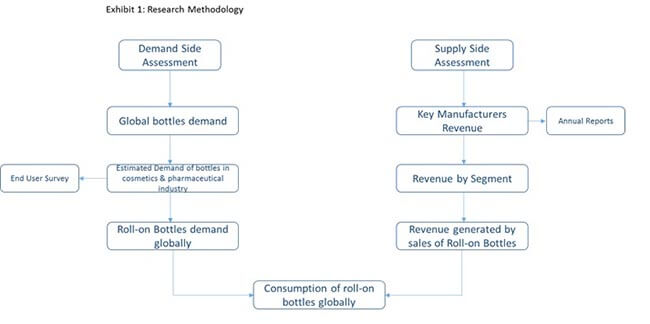Roll-on bottles are bottles made up of glass, aluminum or plastic material which has roller ball placed as a primary closure over it. The roller balls have minute holes through which the oil or any blend is passed while using.
These roll-on bottles are ideal for the packaging of various personal care products. These bottles are very convenient, and provide an economical way to apply blends, essential oils and perfumes.
These are perfect for applying diluted essentials directly to the skin. Roll-on bottles are available in two formats in the market, which are - refillable and non-refillable roll-on configurations.
The advantage of refillable roll-on bottles is that they allow consumers to pre-dilute the blend so that they can be applied directly to the skin without spills and messy drips. Advantage of using roll-on bottles is that they can be kept inside the pocket with ease and applied easily.
Roll-on bottles are available in various shapes and sizes in the market, with capacities ranging from 1 ml to 30 ml. These bottles find useful applications in the cosmetics and pharmaceutical industries.
For roll-on bottles, the quality of roller balls is crucial, as the ball will directly come in contact with the skin. If the quality of roller ball is not good enough, it might affect the consumer. For this purpose, quality of roller ball is taken into consideration.

The sources which have been used to validate the estimated market size include annual reports of market players, magazines, and other relevant data available. Other sources include primary responses from industry experts, distributors, and consultants among others.
Roll-on bottles are important in industries including cosmetics and pharmaceuticals. These are effective for applying essential oils, blends or perfumes. Let’s see some of the advantages of roll-on bottles:
The roll-on bottle market is a niche market which is difficult to subdivide, it’s a growing market due to increasing use of roll-on bottles in cosmetics and pharmaceutical industries.
The material used for the manufacturing of roll-on bottles are glass, plastic and aluminum. Glass is mostly used for the manufacturing of roll-on bottles as it do not react with essential oils and other types of blends placed inside it.
*The pricing analysis can be done on the basis of material type used.
Tier 1 companies-
Companies with revenue US$ 10 Mn & above:
Tier 2 companies-
Companies with revenue ranging from US$ 5 Mn to US$ 10 Mn:
Tier 3 Companies
Companies with revenue below US$ 5 Mn:
The research report presents a comprehensive assessment of the market and contains thoughtful insights, facts, historical data, and statistically supported and industry-validated market data.
It also contains projections using a suitable set of assumptions and methodologies. The research report provides analysis and information according to market segments such as geographies, application, and industry.
The report is a compilation of first-hand information, qualitative and quantitative assessment by industry analysts, inputs from industry experts and industry participants across the value chain.
The report provides in-depth analysis of parent market trends, macro-economic indicators and governing factors along with market attractiveness as per segments. The report also maps the qualitative impact of various market factors on market segments and geographies.
The global roll-on bottle market has been segmented as follows:
On the basis of material type, the global roll-on bottle market has been segmented as:
On the basis of roller ball used, the global roll-on bottle market has been segmented as:
On the basis of capacity, the global roll-on bottle market has been segmented as:
On the basis of end use industry, the global roll-on bottle market has been segmented as:






Full Research Suite comprises of:
Market outlook & trends analysis
Interviews & case studies
Strategic recommendations
Vendor profiles & capabilities analysis
5-year forecasts
8 regions and 60+ country-level data splits
Market segment data splits
12 months of continuous data updates
DELIVERED AS:
PDF EXCEL ONLINE
Bottles Market Analysis - Growth & Forecast 2025 to 2035
PET Bottles Market Demand and Insights 2025 to 2035
PCR Bottles Market Growth - Demand, Innovations & Outlook 2024 to 2034
Beer Bottles Market Size and Share Forecast Outlook 2025 to 2035
Market Share Insights for Beer Bottles Providers
MDPE Bottles Market
Smart Bottles Market Size and Share Forecast Outlook 2025 to 2035
Glass Bottles And Containers Market Size and Share Forecast Outlook 2025 to 2035
Serum Bottles Market Size and Share Forecast Outlook 2025 to 2035
Glass Bottles Market Size, Share & Forecast 2025 to 2035
Paper Bottles Market Growth - Demand & Forecast 2025 to 2035
Competitive Overview of Glass Bottles Market Share
Market Positioning & Share in the Serum Bottles Market
Dosing Bottles Market Size and Share Forecast Outlook 2025 to 2035
Coffee Bottles Market Insights & Industry Trends 2025 to 2035
Bullet Bottles Market Growth – Demand & Forecast 2025 to 2035
Competitive Overview of Dosing Bottles Providers
Tubes, Bottles and Tottles Market
Plastic Bottles Market Size and Share Forecast Outlook 2025 to 2035
Beveled Bottles Market Growth – Demand & Forecast 2025 to 2035

Thank you!
You will receive an email from our Business Development Manager. Please be sure to check your SPAM/JUNK folder too.
Chat With
MaRIA